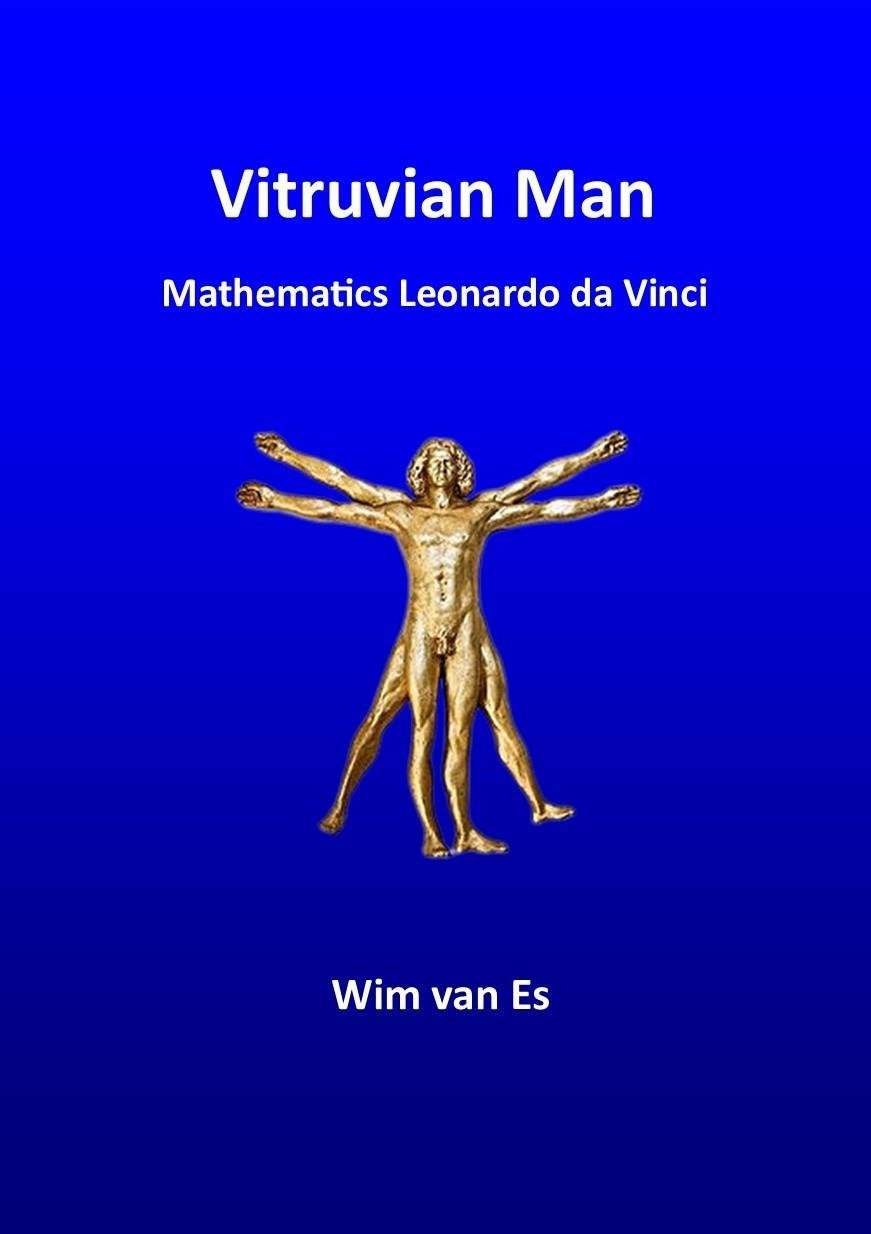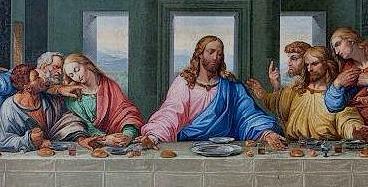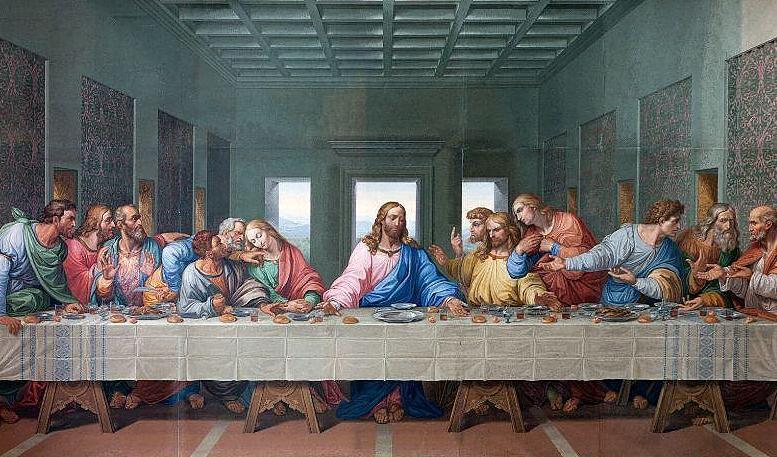Vitruvian Man

Mathematics Leonardo da Vinci
Wim van Es
Wim van Es – Vitruvian man – Mathematics Leonardo da Vinci 3
Preface
Leonardo da Vinci (1452-1519) was an extraordinary person. He was not only a scientist but also a master at hiding important messages in images and writings, assuming that they would be discovered in time. We are now about 520 years later and have so far discovered little of his messages.

We all know the drawing and images of the 'Vitruvian Man'. Designed and drawn by Leonardo da Vinci. We interpret the drawing in our own way, based on what we see and know. We see a man standing in two positions in a circle and square. We set the navel of the man as the center of the circle.
In this publication I explain what else the ’Vitruvian Man’ is. He's a geometric math showpiece if you know how to parse him. And I show the hidden message behind this design.

Wim van Es – Vitruvian man – Mathematics Leonardo da Vinci 4
Wim van Es May 2023
Vitruvian Man
Who was Vitruvius?
Vitruvius (85-20 BC) was an architect at the time of the Romans. He described the proportions of the human body in Latin in his writing 'De architectura'.
He explained that the body fits exactly in an enclosed circle or square centered on the navel (human in circle, human in square). For Vitruvius, the human body was the perfect example of a proportional whole in this regard.
Greek sculptors at that time already used a canon of the ideal proportions of different body parts to each other.
Leonardo da Vinci's 'Vitruvian Man' reflects this ancient practice, which was already practiced in Egyptian sculpture. One of his main propositions is that the length, width, height, and depth of a building should reflect the human size (the proportions of the human body).
Leonardo da Vinci.
Leonardo da Vinci's famous drawing of the 'Vitruvian Man' was one of about 60 illustrations he made for 'De divina proportione'.
Leonardo based himself on the descriptions of Vitruvius, but he carried out empirical research before making the drawing.
Leonardo made the drawing after a study of the (male) human body by Vitruvius but deviated slightly from it because he questioned the dimensions.
So much for the general story.
Wim van Es – Vitruvian man – Mathematics Leonardo da Vinci 5
I am now going to discuss Leonardo da Vinci's drawing, see figure 1. Study the drawing carefully. What do you see?
You see a man standing in two positions, surrounded by a circle and by a square. If you now assume that the navel is the center of the circle, then that is correct.
However, the center of the square is at the height of the male genitalia. And that is different from what Vitruvius stated. How did that happen? Leonardo da Vinci was a prodigious scientist who, through empirical research, came to insights that no one could match.
He turned the drawing into a mathematical riddle, and he was good at it. If you look at the man in figure 1, you may not notice anything. If you now look closely, you will see that the man at the front has 'arm protectors' around his horizontally reinforced forearms. The man at the back with his arms slanted upwards does not have this.
Furthermore, the man at the front, under his apron, wears 'knee breeches' from his genitals to just over his knees.
It is these two aspects, the 'arm protectors' and the 'knee-breeches' that make the drawing of the 'Vitruvian Man' unique.
Simultaneously, the two postures indicate mathematical (geometric) proportions, which are essential in architecture.
Figure 2 shows the drawing of the 'Vitruvian Man' with letters given to the neck, the 'arm protectors' and the 'knee breeches'. A.B.C.D.
Wim van Es – Vitruvian man – Mathematics Leonardo da Vinci 6
and E.

Wim van Es – Vitruvian man – Mathematics Leonardo da Vinci 7
Vitruvian Man
Figure 1

Wim van Es – Vitruvian man – Mathematics Leonardo da Vinci 8
Man
Vitruvian
Figure 2
If we now draw the lines down from B to the circle, you will get the correct foot position. If we are going to draw the lines of the breeches D and E, the blue point is the center of it, figure 3.

Wim van Es – Vitruvian man – Mathematics Leonardo da Vinci 9
Figure 3
Then we draw the connecting lines from the hands to the feet (blue line and red line). And we determine the vertical centerline of the man (blue), figure 4.

Wim van Es – Vitruvian man – Mathematics Leonardo da Vinci 10
Figure 4
What have you drawn now? Two triangles of 72° (divided by the center makes 4 triangles in the ratio √1 - √2 - √3) (blue) and an equilateral triangle of 60° (red), figure 5.

Wim van Es – Vitruvian man – Mathematics Leonardo da Vinci 11
Figure 5
What does this foregoing mean? Perhaps nothing to a layman, because he does not know the meaning of the unique triangle in the ratio, 36° - 54° - 90°. This triangle has the ratio: √1 - √2 - √3 (blue). Its meaning and value is described in detail in my other publications: Mathematics of the Golden Pyramid and Mathematics of the Great Pyramid.
https://www.slideshare.net/WimvanEs1
The triangle, figure 6, is located inside the Golden Pyramid (four equilateral triangles and a square base).
Now what is the value of this triangle? He is the geometric foundation of the number PI (ꙥ). Something that is not yet known. The number Pi (ꙥ) is stated after calculation as a mathematical constant, with a numerical value of 3,141,592,653 in decimal notation … You can determine everything as a human being; however, the geometric basis of the number Pi (ꙥ) is not yet known. And it shows a different decimal notation.

Wim van Es – Vitruvian man – Mathematics Leonardo da Vinci 12
Figure 6
The number PI (ꙥ).
I explained the importance of the number 666 (ratio 6:6:6) in the other publication. This allows you to calculate any angle without sine, cosine, and tangent calculation.
The fact that the number 6 is essential in my trigonometry also makes the number 6 important in this pyramid triangle √1 - √2 - √3.

We take as a starting point (equilateral triangle 6/2) that √1 = 3 cm (figure 7). Then √2 = 4.24 cm and √3 = 5.19 cm.
Pi (ꙥ) = √2 + √3 = 9.43 / √1 = 3 = 3.14333333 ……
Where is the evidence now?
If you have a diameter of 3 cm, then the circumference is 3 x 3.14 = 9.42 cm. We set this based on a workable approach, and we learn that at school. If you would now add the decimals to this, you would get a circumference of 3 x 3,141,592,653 … = 9,424777959 … cm.
Wim van Es – Vitruvian man – Mathematics Leonardo da Vinci 13
Figure 7
Now we set the diameter √1 in the triangle (√1 - √2 - √3) to 3 cm. Then √2 and √3 equals the circumference of the circle. We are now going to reduce the decimals of the roots to 2. That is, √2 = 1.41 cm and √3 = 1.73 cm. Diameter (√1) 3 x (√2) 1.41 = 4.23 cm. Diameter (√1) 3 x (√3) 1.73 = 5.19 cm. This makes together 9.42 cm.
If you now work with infinite decimals and different lengths, you will always get geometric deviations. There is no fixed constant. There is only one fixed constant that recurs in all geometric Pi (ꙥ) ratios and that is 3.14.
To keep the decimal deviations as small as possible, I propose to use two geometrically substantiated Pi (ꙥ) numbers, the Pyramid number Pi 3.1433333 …. on Earth and the Pentagram number Pi 3.1444444 … in the universe. Further explanation is described in my other mathematical publications.
Leonardo da Vinci captured this triangle (√1 - √2 - √3) perfectly in his drawing of the 'Vitruvian Man'.
This unique triangle is reflected in four other geometrically substantiated figures.


Wim van Es – Vitruvian man – Mathematics Leonardo da Vinci 14
Pentagram
- Pentagon Square - Circle.
The triangle is also in the Golden Pyramid and is present in every Cube.

A-B is √1, B-C is √2 and A-C is √3.
This means that the number Pi (ꙥ) is geometrically provable in the Pyramid, the Cube, the Pentagram - Pentagon combination and the Circle - Square combination.

Wim van Es – Vitruvian man – Mathematics Leonardo da Vinci 15
Golden Pyramid Cube
The 'Vitruvian Man' also shows the equilateral triangle of 60°. My other publications clearly explain how unique this triangle is, how it replaces the sine, cosine, and tangent calculation, and how it features the number Phi (Ҩ) in its ratio.

Wim van Es – Vitruvian man – Mathematics Leonardo da Vinci 16
Figure 8
Figure 8 shows the number Phi (Ҩ) in its ratio. This ratio is present in every equilateral triangle and can be calculated. It's the center of the triangle, and if you draw a circle around it, it's the center of the circle. I explain this in figure 9. The number 6 and the ratio 6:6:6 is essential in the calculation of Trigonometry, without using the sine, cosine, and tangent calculation. Underlying all geometric calculations is an equilateral triangle with three sides of 6 cm (60 mm) each. Based on this equilateral triangle, the number Phi (Ҩ) is determined.
The number Phi (Ҩ).
How do I get the number Phi (Ҩ) (1.61) in the equilateral triangle? The ratio 6:6:6 is again essential.

Wim van Es – Vitruvian man – Mathematics Leonardo da Vinci 17
Figure 9
Draw an equilateral triangle with sides of 6 cm. The straight side is then √3 = 5.196 cm. Figure 9. Now how do you determine the center point of the triangle, which allows you to draw a circle around it? To do this, you divide the corners through the middle, so that you get two diagonals of 5.196 cm. If you now measure the distance at which the points intersect in the middle, 1.61 (Phi, Ҩ) will appear at the bottom.
The center point of an equilateral triangle of 12 cm is then twice as large, is 1.61 x 2 = 3.22 cm. You have all equilateral triangles reduce to the ratio 6:6:6.
Phi = sum of the two hypotenuses minus the sum of two straight sides. Phi = (2 x 6) – (2 x 5.196) = 12 – 10,39 = 1.61.

(3.586 + 1,61 : 5.196 – 3.586)
The explanation regarding the Golden Spiral can be found in my publication ’Mathematics of the Great Pyramid’ and in ’The pure Cube’.
Wim van Es – Vitruvian man – Mathematics Leonardo da Vinci 18
Golden Spiral - W.v.Es.
Now there is something else important to see in Leonardo's drawing. If you draw C in figure 2 horizontally and draw the A positions (arm protectors) vertically downwards, you get figure 10.

Wim van Es – Vitruvian man – Mathematics Leonardo da Vinci 19
Figure 10
If you now connect the dots, you will get a perfect pentagram with the navel as the center, figure 11.

Wim van Es – Vitruvian man – Mathematics Leonardo da Vinci 20
Figure 11
Resume.

As I mentioned earlier, Leonardo da Vinci was a master at hiding messages that he assumed would be recognized at a certain time.
His drawing, the 'Vitruvian Man', is therefore more than you think it is when you see the depth behind it.
You may wonder why he did this? Why did he combine his geometric knowledge with arm protectors and knee breeches? Why has no one ever seen this?
Or is the triangle the time (year) of revelation? As I described in the booklet Secrets of the Great Pyramid.
https://www.slideshare.net/WimvanEs1
Time will tell.
This publication is intended to provide insight into how to view, study and explain Leonardo da Vinci's drawing of the 'Vitruvian Man'.
You can then determine for yourself whether Leonardo connected other hidden messages to his other works of art. And that also applies to 'other messengers'.
Wim van Es – Vitruvian man – Mathematics Leonardo da Vinci 21
The art of perception is to see what you cannot see.

Wim van Es – Vitruvian man – Mathematics Leonardo da Vinci 22
There are three classes of people: those who see, those who see when someone shows them, those who don't see.
Leonardo da Vinci


























